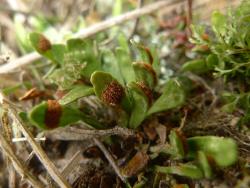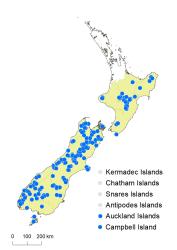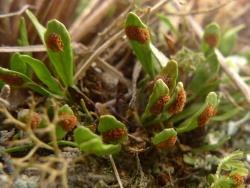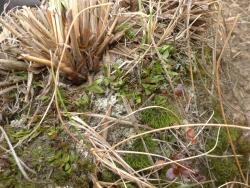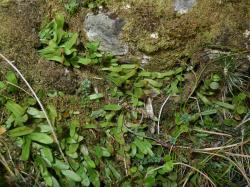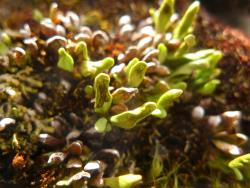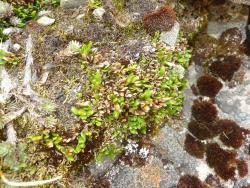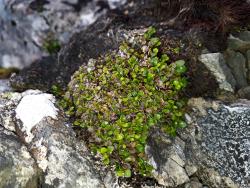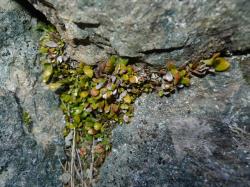- ≡ Polypodium crassium Kirk, Trans. & Proc. New Zealand Inst. 17: 232 (1885)
- = Grammitis australis var. alpina S.Jones, Handb. Ferns New Zealand 31 (1861)
- = Grammitis pumila J.B.Armstr., Trans. & Proc. New Zealand Inst. 13: 341 (1881) nom. illeg., non Grammitis pumila Sw.
- ≡ Polypodium australe var. pumilum (J.B.Armstr.) Cockayne, Trans. & Proc. New Zealand Inst. 36: 325 (1904) – as P. australe pumila
- ≡ Polypodium pumilum (J.B.Armstr.) Cockayne, Rep. Bot. Surv. Stewart Island 47 (1909)
- ≡ Polypodium billardierei var. pumilum (J.B.Armstr.) Cheeseman, Man. New Zealand Fl., ed. 2, 80 (1925)
- = Grammitis armstrongii Tindale, Contr. New South Wales Natl. Herb. 3: 88 (1961)
Rhizomes long-creeping, bearing scales. Rhizome scales ovate to narrowly ovate, 1.0–6.5 mm long, 0.3–2.0 mm wide, pale brown, concolorous, non-clathrate. Stipes indistinct, winged almost to base, glabrous. Fronds undivided, linear to obovate or spathulate, 4–42 mm long, 1–5 mm wide; apices acute to obtuse; margins entire; bases attenuate to an indistinct winged stipe; both surfaces pale green; coriaceous; usually glabrous or occasionally bearing sparse hairs up to 0.6 mm long on the lamina surface. Hairs simple catenate, or branched with catenate branches. Hydathodes absent. Sori subglobose to globose on veins, slightly oblique, usually becoming confluent at maturity, 1–3 mm long, in 1–5 pairs, or rarely up to 7 pairs, confined to frond apices, lacking hairs. Sporangia 210–400 µm long; spores 31–65 µm diameter.
Notogrammitis crassior is characterised by its long-creeping rhizomes, indistinct stipes, very small fronds (up to 42 mm long and 5 mm wide), lack of hairs, and sori that are confined to the frond apices. Its habitat is almost exclusively alpine or subalpine, very rarely in forest, and its small, glabrous fronds will distinguish it from N. givenii, N. gunnii and N. patagonica, which also occur in this zone. It lacks setae or hairs with setiform branches.
North Island: Volcanic Plateau, Gisborne, Taranaki, Southern North Island.
South Island: Western Nelson, Sounds-Nelson, Marlborough, Westland, Canterbury, Otago, Southland, Fiordland.
Stewart Island, Auckland Islands, Campbell Island.
Altitudinal range: 250–1900 m.
Notogrammitis crassior is confined to alpine and subalpine areas of the North Island from the Raukūmara Ranges and Mt Taranaki to the Tararua and Aorangi Ranges, mostly in a zone from 800 to 1650 m. In the South Island it occurs in alpine and subalpine areas throughout, ranging from 250 m in the Hunters Hills, Canterbury, to over 1900 m at the Waiau Pass, Nelson, but it is usually found above 750 m. It also reaches Stewart Island, and descends to c. 250 m on the subantarctic islands.
Also Chile, Argentina, Falkland Islands, South Georgia, Tristan da Cunha, Gough Island, Nightingale Island, Inaccessible Island, Marion Island, Prince Edward Island, Crozet Islands, Kerguelen Islands, and Australia (New South Wales, Victoria, Tasmania, Macquarie Island) (Perrie & Parris 2012).
Notogrammitis crassior is found in mountain beech forest, subalpine scrub, tussock, subalpine grassland, and in alpine fellfield and herbfield. It is a rare epiphyte on mountain beech, and usually forms mats on mossy rocks and cliff faces, in rock crevices, among scree, and under rock overhangs. It is often associated with alpine mosses such as Racomitrium. It occurs on a wide variety of substrates, including greywacke, granite, gneiss, schist, basalt, limestone, marble, ash, and andesite. It is one of the few truly alpine ferns in New Zealand and occurs at higher altitudes than most other New Zealand pteridophytes (Parris & Given 1976).
n = 37 (Brownlie 1958 – as Grammitis pumila). Counts of n = 37 and n = 74 have been reported from Australian populations (Parris 1998; Tindale & Roy 2002) with n = 37 reported from high alpine material and n = 74 from forest material.
Kirk (1885) described his new species as Polypodium crassium. The epithet “crassium” is a neuter comparative, but is not good Latin and should have been “crassius”. Allan (1961) pointed out that the word is spelled “crassum” on the type sheet, and suggested that it had been misspelled when published, thereby implying that “crassium” was an orthographic error to be corrected to “crassum”. This had been accepted by Christensen (1905–1906), who treated it as P. crassum, and by Copeland (1951), who thought “the specific name is probably a misprint”. However, another interpretation is that Kirk intended to use a comparative adjective, “crassium”, to distinguish the name of his species from Grammitis crassa Fée, albeit in the genus Polypodium. Whether Kirk knew of G. crassa Fée is uncertain because the name was not used in any New Zealand Flora until that of Allan (1961), following the work of Copeland (1951). If the name Polypodium crassium is treated as an orthographic error for P. crassum, the combination in Grammitis is unavailable because of G. crassa Fée, but is available in Notogrammitis.
Notogrammitis crassior was previously known as Grammitis poeppigiana (Mett.) Pic.Serm. (e.g. Parris 1998; Brownsey & Smith-Dodsworth 2000). However, the neotype of Polypodium poeppigianum Mett. is actually a specimen of Notogrammitis angustifolia and has been reduced to synonymy under that species (Perrie & Parris 2012).
No type was specified for Grammitis australis var. alpina by Jones (1861), and its synonymy with Notogrammitis crassior is based on historical precedent first determined by Perrie & Parris (2012).
Perrie & Parris (2012) showed that, based on chloroplast DNA sequences, populations of N. crassior in Australia and Chile differ substantially from those in New Zealand. Some plants in Australia from forest are also known to be tetraploid (Parris 1998), in contrast to those in New Zealand. Further work is needed to determine whether habitat, ploidy and sequence differences are correlated.



